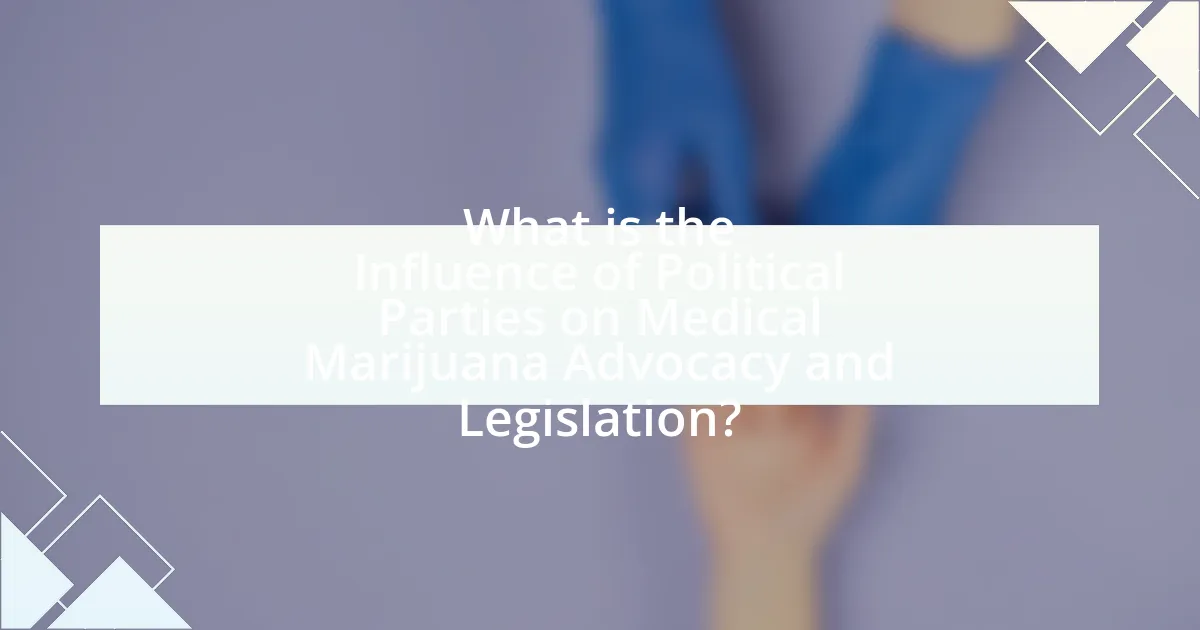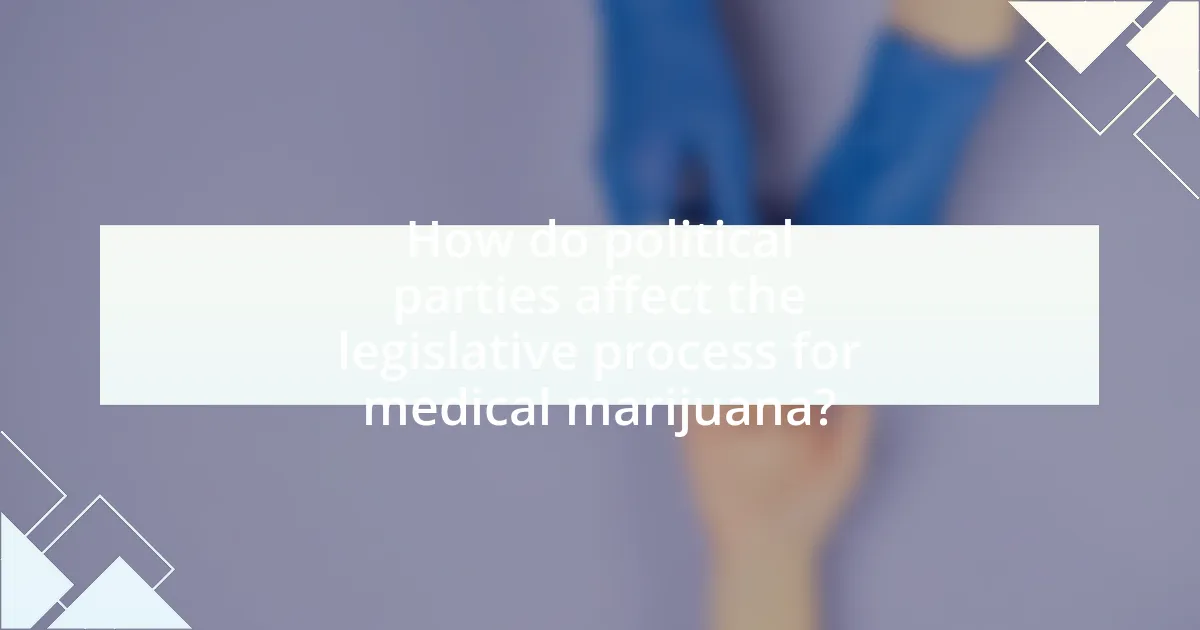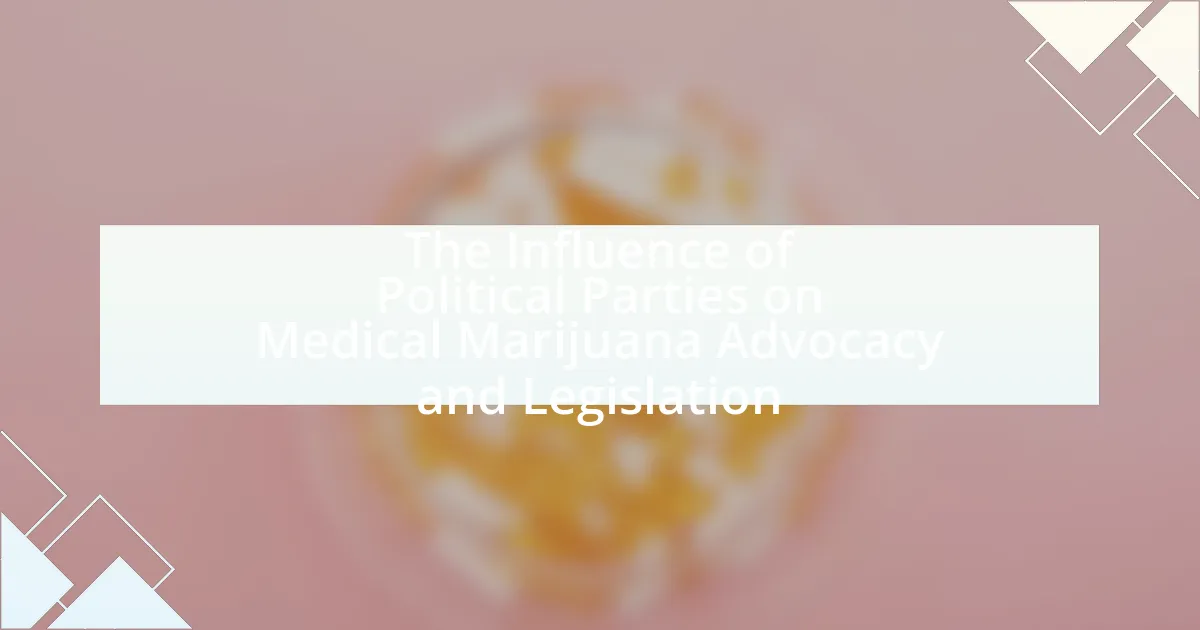The article examines the significant influence of political parties on medical marijuana advocacy and legislation in the United States. It highlights how Democratic Party members generally support medical marijuana legalization due to its therapeutic benefits, while Republican Party members often express concerns regarding regulation and public health. The article discusses the impact of party platforms, ideologies, and public opinion on legislative outcomes, illustrating how states with Democratic majorities are more likely to pass medical marijuana laws compared to those with Republican leadership. Additionally, it explores the roles of grassroots movements, third parties, and lobbying efforts in shaping the discourse and legislative process surrounding medical marijuana.

What is the Influence of Political Parties on Medical Marijuana Advocacy and Legislation?
Political parties significantly influence medical marijuana advocacy and legislation through their platforms, policies, and legislative actions. For instance, Democratic Party members generally support medical marijuana legalization, citing its therapeutic benefits, while Republican Party members often express concerns about regulation and public health. This division is evident in state-level legislation; states with Democratic majorities have more frequently passed medical marijuana laws, such as California’s Proposition 215 in 1996, which was the first in the U.S. to legalize medical marijuana. Conversely, states with Republican leadership have been slower to adopt similar measures, reflecting the party’s more conservative stance on drug policy. This partisan divide shapes public discourse and impacts the legislative process, ultimately determining the extent to which medical marijuana is accepted and regulated across the country.
How do political parties shape the discourse around medical marijuana?
Political parties shape the discourse around medical marijuana by influencing public opinion, legislative agendas, and policy frameworks. For instance, Democratic parties often advocate for the legalization and medical use of marijuana, framing it as a public health issue and a matter of personal freedom, which can lead to increased support among constituents. Conversely, Republican parties may emphasize concerns about public safety and health risks, often advocating for stricter regulations or opposing legalization altogether. This divergence in party positions affects how medical marijuana is discussed in media, legislative debates, and among the electorate, ultimately impacting the laws and regulations that govern its use. Historical data shows that states with Democratic leadership are more likely to pass medical marijuana legislation, reflecting the party’s supportive stance on the issue.
What roles do party platforms play in medical marijuana advocacy?
Party platforms serve as official statements of a political party’s stance on various issues, including medical marijuana advocacy. These platforms influence legislative priorities and shape public perception by outlining the party’s commitment to medical marijuana policies, which can mobilize voters and attract support from advocacy groups. For instance, the Democratic Party’s platform has historically included support for the legalization of medical marijuana, reflecting broader public opinion trends and influencing state-level legislation. This alignment can lead to increased funding for research and development of medical marijuana programs, as seen in states where party platforms advocate for such measures.
How do party ideologies influence legislative outcomes for medical marijuana?
Party ideologies significantly influence legislative outcomes for medical marijuana by shaping the priorities and voting behaviors of lawmakers. For instance, Democratic lawmakers generally support medical marijuana legalization due to their party’s progressive stance on social issues, while Republican lawmakers often oppose it, reflecting a more conservative viewpoint on drug policy. This ideological divide is evident in legislative sessions; states with Democratic majorities have passed more comprehensive medical marijuana laws, such as California’s Proposition 215 in 1996, compared to states with Republican control, where such measures face greater resistance. Additionally, public opinion trends, which often align with party ideologies, further impact legislative outcomes, as seen in surveys indicating higher support for medical marijuana among Democratic voters.
Why is understanding political party influence important for medical marijuana legislation?
Understanding political party influence is crucial for medical marijuana legislation because political parties shape policy priorities and legislative outcomes. Political parties often have distinct platforms regarding drug policy, which can significantly affect the introduction, support, or opposition to medical marijuana laws. For instance, in the United States, research indicates that states with Democratic majorities are more likely to pass medical marijuana legislation compared to those with Republican leadership, reflecting the parties’ differing stances on cannabis reform. This influence is evident in voting patterns and legislative agendas, where party alignment can determine the success or failure of medical marijuana initiatives.
What historical examples illustrate political party influence on medical marijuana laws?
Political parties have significantly influenced medical marijuana laws in various historical contexts. For instance, in the 1990s, the Democratic Party’s support for medical marijuana was evident when California became the first state to legalize it for medical use in 1996, largely driven by Democratic lawmakers and advocacy groups. Conversely, during the early 2000s, the Republican Party’s stance against marijuana led to stricter federal enforcement, exemplified by the Bush administration’s crackdown on state-legal medical marijuana dispensaries. Additionally, the shift in the Democratic Party’s platform in the 2010s, which included support for legalization, further propelled states like Colorado and Washington to legalize recreational and medical marijuana in 2012, showcasing how party ideology can shape legislative outcomes. These examples illustrate the direct correlation between political party positions and the evolution of medical marijuana laws in the United States.
How does public opinion intersect with political party positions on medical marijuana?
Public opinion significantly influences political party positions on medical marijuana, as parties often align their policies with the prevailing views of their constituents. For instance, a 2021 Gallup poll indicated that 68% of Americans support legalizing medical marijuana, prompting many political parties to adopt more favorable stances on the issue to resonate with voters. This alignment is evident in the Democratic Party, which has increasingly advocated for medical marijuana legalization, reflecting the majority support among its base. Conversely, some Republican factions remain cautious, often reflecting the views of their more conservative constituents, yet there is a growing trend within the party towards supporting medical marijuana due to shifting public sentiment. Thus, the intersection of public opinion and political party positions on medical marijuana is characterized by a responsive dynamic, where parties adjust their platforms to align with the evolving attitudes of the electorate.

What are the key political parties involved in medical marijuana advocacy?
The key political parties involved in medical marijuana advocacy are the Democratic Party and the Libertarian Party. The Democratic Party has historically supported medical marijuana legalization, with numerous members advocating for reform at both state and federal levels, as evidenced by the inclusion of pro-cannabis policies in their platforms. The Libertarian Party also champions medical marijuana, emphasizing individual freedom and limited government intervention, which aligns with their stance on drug policy reform. Additionally, some members of the Republican Party have shown support for medical marijuana, particularly in states where it has gained popular approval, reflecting a growing bipartisan trend in favor of medical cannabis legislation.
How do Democratic and Republican parties differ in their approach to medical marijuana?
The Democratic Party generally supports the legalization and expansion of medical marijuana, advocating for its therapeutic benefits and pushing for federal decriminalization. In contrast, the Republican Party tends to be more cautious, with many members expressing concerns about potential abuse and the implications for public health, although some Republicans do support state-level medical marijuana initiatives. This divergence is evident in legislative actions, where Democrats have introduced bills aimed at protecting and expanding access to medical marijuana, while Republicans often prioritize regulatory frameworks that limit its use.
What specific policies do Democrats advocate regarding medical marijuana?
Democrats advocate for the legalization of medical marijuana at the federal level, emphasizing the need to remove it from the Schedule I classification under the Controlled Substances Act. This policy aims to facilitate research and access for patients who could benefit from medical cannabis. Additionally, Democrats support measures that allow states to implement their own medical marijuana programs without federal interference, reflecting a commitment to states’ rights. Evidence of this advocacy is found in the Democratic Party’s platform, which explicitly calls for the decriminalization of marijuana and the expungement of prior convictions related to marijuana offenses, highlighting a broader approach to criminal justice reform.
What specific policies do Republicans advocate regarding medical marijuana?
Republicans generally advocate for a cautious approach to medical marijuana, emphasizing states’ rights to regulate its use rather than federal legalization. Many Republican lawmakers support legislation that allows states to determine their own medical marijuana policies, reflecting a belief in limited federal intervention. For instance, the Rohrabacher-Farr amendment, which has been supported by some Republicans, prohibits the Department of Justice from interfering with state medical marijuana laws. Additionally, some Republicans advocate for research into the medical benefits of cannabis while maintaining a focus on public health and safety concerns.
What third parties or movements influence medical marijuana legislation?
Various third parties and movements significantly influence medical marijuana legislation, including advocacy groups, medical associations, and social movements. Organizations such as the National Organization for the Reform of Marijuana Laws (NORML) and the Marijuana Policy Project (MPP) actively lobby for legalization and reform, providing research and public education to support their initiatives. Additionally, medical associations, like the American Medical Association (AMA), contribute to the dialogue by offering professional perspectives on the therapeutic benefits and risks of medical marijuana. Social movements, particularly those focused on drug policy reform and social justice, also play a crucial role by mobilizing public support and influencing policymakers through grassroots campaigns. These entities collectively shape the legislative landscape surrounding medical marijuana by advocating for policy changes and raising awareness about its potential benefits.
How do independent and third-party candidates impact medical marijuana advocacy?
Independent and third-party candidates significantly impact medical marijuana advocacy by introducing alternative perspectives and policies that challenge the mainstream political narrative. These candidates often prioritize issues like drug reform and social justice, which can elevate the conversation around medical marijuana in ways that major party candidates may not. For instance, in the 2020 election, candidates like Jo Jorgensen of the Libertarian Party advocated for the legalization of marijuana, thereby bringing attention to the topic and influencing public discourse. Their presence can mobilize voters who feel disenfranchised by the two-party system, potentially increasing grassroots support for medical marijuana initiatives. This shift in advocacy can lead to greater legislative attention and action on medical marijuana issues, as seen in states where independent candidates have garnered significant support.
What role do grassroots movements play in shaping party positions on medical marijuana?
Grassroots movements significantly influence party positions on medical marijuana by mobilizing public support and advocating for policy changes. These movements often engage in campaigns that raise awareness about the benefits of medical marijuana, thereby shifting public opinion and pressuring political parties to adopt more favorable stances. For instance, the National Organization for the Reform of Marijuana Laws (NORML) has played a crucial role in advocating for medical marijuana legalization, which has led to various political parties reevaluating their platforms to align with the growing public support for such measures. This alignment is evidenced by the increasing number of states that have legalized medical marijuana, reflecting a broader acceptance that political parties cannot ignore without risking voter backlash.

How do political parties affect the legislative process for medical marijuana?
Political parties significantly influence the legislative process for medical marijuana by shaping policy priorities and determining the likelihood of passing related legislation. For instance, in the United States, Democratic Party members generally support medical marijuana legalization, while Republican Party members may oppose it, reflecting broader ideological divides. This partisan alignment affects committee assignments, debate dynamics, and voting patterns, as seen in states like California, where Democratic majorities have facilitated the passage of medical marijuana laws. Conversely, in states with Republican control, such as Texas, legislative efforts to expand medical marijuana access face substantial hurdles. Thus, the political party in power directly impacts the speed and scope of medical marijuana legislation.
What strategies do political parties use to promote or hinder medical marijuana legislation?
Political parties employ various strategies to promote or hinder medical marijuana legislation, including lobbying, public messaging, and coalition-building. For promotion, parties may engage in lobbying efforts to influence lawmakers, utilize social media campaigns to raise public awareness, and form coalitions with advocacy groups to strengthen their position. For instance, the Democratic Party has often supported medical marijuana initiatives, citing public health benefits and social justice, while the Republican Party may focus on regulatory concerns and public safety to hinder such legislation. Evidence of these strategies can be seen in states where party platforms directly influence legislative outcomes, such as California’s legalization efforts driven by Democratic support and opposition from conservative factions.
How do lobbying efforts by political parties influence medical marijuana laws?
Lobbying efforts by political parties significantly influence medical marijuana laws by shaping public policy and legislative outcomes through strategic advocacy. Political parties often mobilize resources to support or oppose medical marijuana initiatives, leveraging their networks to sway lawmakers and public opinion. For instance, the National Organization for the Reform of Marijuana Laws (NORML) has documented how party-affiliated lobbying groups have successfully pushed for legalization in various states, resulting in over 30 states legalizing medical marijuana by 2023. These lobbying efforts can lead to the introduction of favorable legislation, amendments to existing laws, or even the defeat of restrictive measures, demonstrating the direct impact of political party lobbying on the evolution of medical marijuana laws.
What legislative tactics are employed by parties to advance or block medical marijuana initiatives?
Political parties employ various legislative tactics to advance or block medical marijuana initiatives, including lobbying, coalition-building, and strategic use of legislative procedures. For instance, parties in favor of medical marijuana often engage in lobbying efforts to influence lawmakers and public opinion, while those opposed may utilize similar tactics to sway legislators against such initiatives. Additionally, coalition-building with advocacy groups can amplify support or opposition, as seen in states where medical marijuana has been legalized through grassroots campaigns. Furthermore, parties may strategically use legislative procedures, such as introducing amendments or delaying votes, to either expedite the passage of medical marijuana laws or obstruct them, reflecting their political agendas and the influence of their constituents.
What are the implications of political party influence on medical marijuana legislation?
Political party influence significantly shapes medical marijuana legislation, often determining the speed and extent of legalization efforts. For instance, in the United States, Democratic-led states have generally been more supportive of medical marijuana initiatives, resulting in more comprehensive laws and faster implementation compared to Republican-led states, which may impose stricter regulations or oppose legalization altogether. This trend is evidenced by the fact that as of 2023, 39 states have legalized medical marijuana, with a majority of these states having Democratic governors or legislatures, highlighting the correlation between political affiliation and legislative outcomes.
How does political party influence affect access to medical marijuana for patients?
Political party influence significantly affects access to medical marijuana for patients by shaping legislation and public policy. For instance, states governed by Democratic majorities tend to have more progressive stances on medical marijuana, often leading to more accessible programs for patients. In contrast, Republican-led states may impose stricter regulations or oppose legalization efforts, limiting patient access. A study by the National Conference of State Legislatures found that as of 2021, 36 states and the District of Columbia had legalized medical marijuana, with a majority of these states having Democratic leadership at the time of legalization. This correlation illustrates how political party dynamics directly impact the availability of medical marijuana for patients.
What are the long-term effects of political party positions on medical marijuana policy?
Political party positions significantly shape the long-term trajectory of medical marijuana policy, influencing legislation, public perception, and access to medical cannabis. For instance, states governed by Democratic leadership tend to adopt more progressive medical marijuana laws, as evidenced by the legalization efforts in California and New York, where Democratic majorities have facilitated comprehensive medical cannabis programs. Conversely, Republican-led states often exhibit more restrictive policies, as seen in Texas, where medical marijuana access remains limited despite public support. This divergence in policy reflects the broader ideological divides, with Democratic platforms generally advocating for drug reform and Republican platforms often emphasizing law enforcement and public health concerns. Over time, these political stances can entrench disparities in access to medical marijuana, affecting patient outcomes and shaping the national dialogue on cannabis reform.
What can advocates learn from the political landscape surrounding medical marijuana?
Advocates can learn that the political landscape surrounding medical marijuana is heavily influenced by party ideologies and public opinion. For instance, states with Democratic leadership tend to have more progressive policies regarding medical marijuana, as evidenced by the legalization efforts in states like California and New York, where Democratic governors and legislatures have supported such measures. Conversely, Republican-led states often exhibit more restrictive approaches, reflecting conservative values that prioritize traditional drug policies. This pattern indicates that advocates should align their strategies with the prevailing political climate and engage in bipartisan dialogue to enhance their chances of success in legislative efforts.
What strategies can advocates employ to navigate political party dynamics effectively?
Advocates can navigate political party dynamics effectively by building bipartisan coalitions and engaging in strategic communication. Bipartisan coalitions allow advocates to unite supporters from different political backgrounds, increasing the chances of legislative success. For instance, the successful passage of medical marijuana laws in states like California and Colorado involved collaboration between Democrats and Republicans, demonstrating that cross-party alliances can enhance advocacy efforts. Additionally, strategic communication tailored to resonate with the values and priorities of different political parties can help advocates frame their messages in a way that appeals to a broader audience, thereby fostering support across the political spectrum.
How can understanding political party influence improve advocacy efforts for medical marijuana?
Understanding political party influence can significantly enhance advocacy efforts for medical marijuana by aligning strategies with the values and priorities of key political stakeholders. Political parties often shape public policy and legislative agendas; thus, recognizing their positions on medical marijuana can help advocates tailor their messaging and outreach to resonate with party platforms. For instance, research indicates that states with Democratic majorities are more likely to support medical marijuana legislation, as seen in the passage of laws in states like California and New York. By leveraging this knowledge, advocates can effectively mobilize support from party members, engage in strategic lobbying, and create coalitions that amplify their efforts, ultimately leading to more favorable legislative outcomes for medical marijuana initiatives.

Leave a Reply